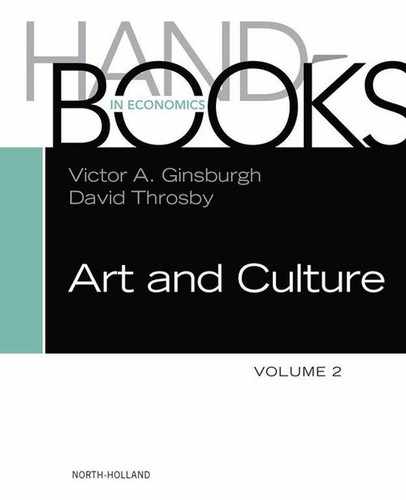Table of Contents
Chapter 1. Introduction and Overview
1.2 Value and Evaluation in Art and Culture
1.3 Demand, Consumption, and Investment
1.4 Innovation and Technological Change
1.5 Trade, Development, and Cultural Diversity
PART I: Value and evaluation in art and culture
Chapter 2. Creative Genius in Literature, Music, and the Visual Arts
Chapter 3. Contemporary Experimental Aesthetics: Procedures and Findings
3.3 Processes Underlying an Aesthetic Experience with Visual Art
3.4 The Viewer’s Contribution to an Aesthetic Experience
3.5 The Art Museum as Laboratory
Chapter 4. The Economic and Cultural Value of Paintings: Some Empirical Evidence
5.3 Music’s Value for Listener, Performer, And Composer
5.5 The Centrality of Music in Human Life
5.6 The Artistic Value of Music
5.7 Music’s Extra-Artistic Value
5.10 Music’s Self-Affirmation Value
5.12 Music’s Idiosyncratic Value
5.13 Music’s Mood-Enhancement Value
5.14 Music’s Accompaniment Value
Chapter 6. The Economics of Cultural Awards
Chapter 7. The Use of Stated Preference Methods to Value Cultural Heritage
7.2 Contingent Valuation Methods
7.4 Discrete Choice Experiment Models
7.5 Estimating Price from Choice Experiments
7.6 Enhancing Choice Experiment Models
PART II: Demand, consumption and investment
Chapter 8. Bestsellers and Blockbusters: Movies, Music, and Books
8.2 Conceptual Models: Bestsellers and Blockbusters
8.3 Empirical Models: Bestsellers and Blockbusters
8.4 A Selective Survey of Empirical Findings
8.5 Conclusions: Some Interesting Issues for Further Research
Chapter 9. New Technologies and Cultural Consumption
9.2 New Technology Changes Relative Price
9.3 New Technology Increases Variety
9.4 New Technology Induces New Preferences
Chapter 10. Investment in Visual Art: Evidence from International Transactions
10.2 Testable Implications of International Art Sales
10.3 Real Exports of Paintings, Prints, and Sculptures
10.4 The Correlation Between Exports of Artworks, Consumer Goods, and Capital Goods
10.5 Art Trade and Permanent Income
PART III: Innovation and technological change
Chapter 11. Cultural Innovation by Cultural Organizations
11.2 The Determinants of Cultural Innovation by Cultural Organizations
11.3 Conclusion: Summary and Future Research
Chapter 12. Digitization, Copyright, and the Flow of New Music Products
12.3 Effects on Demand and Their Documentation
12.4 Revenue Reduction and Cost Reduction
12.6 Direct Quantity Evidence on the Service Flow of New Products
12.7 Explaining Increased Quality
Chapter 13. The Pricing of Art and the Art of Pricing: Pricing Styles in the Concert Industry
13.2 The Live Event Industry: Facts, Literature Review, and Open Questions
13.3 Data and Summary Statistics
13.4 Price Discrimination: Measurement Issues
13.5 Price Discrimination at the Concert Level
13.6 Price Discrimination at the Artist Level
13.7 Identifying Artists’ Pricing Styles
13.8 Candidate Explanation for the Use of Price Discrimination
13.9 Exploitation of Market Power
13.11 Overview and Future Research
Chapter 14. Media Ownership: Diversity Versus Efficiency in a Changing Technological Environment
14.2 The Effects of Changing Technology
14.3 Concentrated Ownership and Economic Performance
14.4 Sociocultural Implications of Media Ownership
14.5 Media Ownership and Public Policy
PART IV: Trade, development, and cultural diversity
Chapter 15. Cultural Products in the International Trading System
15.2 The Debate on Trade and Culture
15.5 The Global Governance of Cultural Policies: Normative Issues at the International Level
15.6 Conclusions and Suggestions for Future Research
Chapter 16. Cultural Diversity, Copyright, and International Trade
16.2 Cultural Diversity as a Concept in International Law?
16.5 Copyright as Part of the Trips Agreement
Chapter 17. Trade and Cultural Diversity
17.2 Theoretical Perspectives on International Trade and Cultural Diversity
17.3 Dynamic Cultural Transmission Models
17.4 Cultural Transmission and Competitive Economic Exchange
17.5 Factor Endowments, Trade, and Cultural Convergence
17.6 Group Consumption Externalities and Cultural Divergence
17.7 Increasing Returns, Market size effects, and Cultural Dynamics
Chapter 18. Cultural Diversity, Conflict, and Economic Development
18.2 Measuring Ethnic Heterogeneity
18.3 Ethnic Diversity and Economic Outcomes
18.4 Heterogeneity and Conflict
Chapter 19. Culture, Linguistic Diversity, and Economics
19.2 Linguistic Diversity and Fractionalization
PART V: Broader cultural issues
20.1 Cultural Value Orientations to Characterize Societies
20.2 Mapping Cultural Differences Around the World
20.3 Comparison with the Hofstede and Inglehart Dimensions
20.4 Cultural Value Orientations and Economically Significant Variables
Chapter 21. Religion, Culture, and Development
21.2 The Effect of Religion on Individual Behavior
21.3 The Role of Religion as a Response to Market or State Imperfections
21.4 Market Structure Models: The Effect of Competition on Religion
21.5 The State as a Strategic Actor: A Political Economics Approach
Chapter 22. Strategic Interactions Between Modern Law and Custom
22.2 The Effect of Legal Reform on Customary Practices: An Overview of Economic Theories
22.3 Radical or Moderate Legal Reforms?
